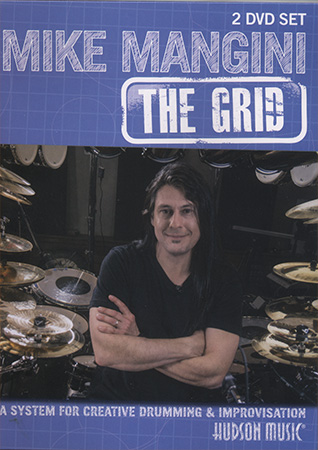
Tiger Bill Reviews
The Grid
A System For Creative Drumming & Improvisation
2-DVD Set
by Mike Mangini
For the sake of full disclosure, Mike and I are friends and have been since we first met back in the start of this century when we we're both involved in the Worlds Fastest Drummer Competitions. That said, if you're worried that this will cause me to publish a biased review, don't worry about it. If anything, I'll be tougher on him than on someone I don't know personally!
Before we get started checking out his 2-DVD Set, let me say that there is a ton of information here and, for the sake of shortening up my review a bit, I'm going to list the contents of each section and then include some of Mike's more crucial suggestions and tips in each major section.
For those of you in a particular hurry, just click on my Bottom Line.
DVD 1 - Opening
P
art 1: Introduction to the Grid
Example 1: 12/8 Blues Groove
Example 2: Rudimental Snare Pattern
Example 3: 2/4 Quintuplet Groove
Example 4: Jazz/Swing Time
Filling in the Grid: Examples
Mike introduces us to his Grid System in this section, which is a chart that covers each attribute that we need to take into consideration when learning to play the drums, which consists of 7 components:
Time Signature--Subdivisions--Dynamics--Instrument Sounds--Limbs--Phrase--Musical Styles
According to Mike, "Those are the 7 categories that account for anything that's ever been played, anything that can be played and anything that could ever be played!"
Mike demonstrates how each of these categories relates to the drumset. I
In the final chapter "Filling in the Grid, " you get to play along as Mike calls the shots.
P
art
2
: Categories of the Grid
Time Signature
Subdivisions
Dynamics
Instrument Sounds
Limbs
Musical Styles
Phrase
Mike breaks down and explains each category in his grid while demonstrating the purpose behind the gear in his "Dream Theater" kit.
P
art
3
: Improvisation
: Thought Process While Improvising
Transitions Example
Dynamics Example
Things to Avoid When improvising
Mike does a great job of explaining and demonstrating the types of grooves and fills that fit together and the types that DON'T!
He also addresses both ultra-beginners and ultra-pros!
P
art 4
: Style Protocols
Protocol 1: Jazz - Stepped Hi-Hat
Protocol 2: Rock - Flams
Protocol 3: Afro-Cuban Sounds
Protocol 4: Funk
Mike demonstrates the various protocols that should be used, especially by beginners, when learning how to improvise in the above four major musical styles.
P
art
5
: Mike's Profile: Dream Theater Kit
Toms
Cannon Toms/Octobans
Bass Drums
Cymbals
Snare Drums
Electronics
Mirror Image Kit
In this section, Mike fills us in on his having to learn 10 albums of "Dream Theater" material that existed before he came to the band and he goes into detail explaining why he has each of the sound sources on his "Dream Theater" kit and his specific uses for each.
Bonus Solo 1
From a 2013 Drum Clinic Mike performed in Rome, Italy.
Also included is a PDF that contains not only a detailed diagram of Mike's Grid System but transcriptions of many of the examples he plays on these two DVDs.
DVD 2 - Opening
P
art
6
:
Interactive
Improvisation Exercises
Snare Drums
Phrase with Fill
Demo: Afro-Cuban Phrase with Fill
Demo: Funk Phrase with Fill
Improvised Solo
In this section, Mike plays the role of your voice in your head as he tells you what you should be thinking about when you are improvising.
P
art
7
: Human At
t
ributes
Coordination
Technique - Mike talks practicing 3 types of squeezes and explains how, as he begins to play faster, he flexes his bigger muscle groups. Mike and I had talked about his approach to drum technique when we first met during the WFD Competitions. I come from the approach that playing under tension is not only bad for your body but is similar to attempting to drive a car at top speed with your foot on the brake. Whereas Mike actually tenses up in many cases before he even starts to play. As one might imagine, I've noticed this approach in Mike's students that he entered into WFD Competitions as well. In my opinion, this is far from a safe and effective approach to drum technique.
Speed - How to practice speeding with your mind and limbs.
Foot Technique - Mike's foot technique consists of much the same process as his hands, as he gains speed he flexes the large muscle groups in his legs. I , again, am the polar opposite of Mike's foot technique. I prefer to use more natural movements of my feet and legs and, as proof, my feet have been clocked at WFD Competitions at over 1,000 bpm using no tension so it definitely is possible to do without the flexing of any muscles.
Subdivision - Various musical styles have different subdivisions. For example, Rock has 4 notes between each beat, Swing/Jazz has 3 beats and Indian music has 5.
Subdivision Solo
PolyRhythms
PolyRhythms Solo Using 6&17
PolyRhythms Solo Using 14
P
art 8
: Playing the Large Kit: Balance
Odd Time-Based Solo
P
art
9
: Ostinato Patterns
One-Limb Ostinato
Two-Limb Ostinato: Baiao
Two-Limb Ostinato with Weaker Limbs
Flam Paradiddle-Diddle
Three-Limb Ostinato
Distinction between practicing to be a better musician is taking things I already know and using them. Practicing things I don't yet play well (things I need to learn) is a mechanical practice, which is important but a different type of practice than musical practice.
This grid has helped everybody I know, including me, figure out who they are by what they do, figure out what their strengths are, what their natural talents are, what they're not, what makes them happy, what exists, and what might make them happy that they don't know until they go and try it.
Bonus Solo 2
Filmed on a Dream Theater Tour.
The Bottom Line
Aside from the different approaches between Mike and I as far as physical drum techniques go, i.e.
Tension-Full vs. Tension-Free, I found Mike's Grid System to be a very comprehensive, precise, and methodical
approach to drumming, when followed as Mike prescribes. Mike's top notch drum performances over the years,
whether backing a band or in creative soloing, is a living testament to the effectiveness of his Grid System.
I highly recommend it drummers of all ages, experience levels, and musical styles.
And you can even get Mike's Grid System at a discount online:
Until next time, Stay loose!
Tiger Bill

